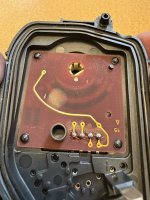Use Windows laptop + FES or
MES and collect data (CSV file), then make XY plot, not screenshots like that (mostly useless).
Try to replicate a graph like mine. Otherwise it doesn't make sense ("diagnosing" a car like that - by screenshots).
In the 1200-2000 RPM range, the VVT starts to operate while driving (>2000 when stationary)...
That's another thing to diagnose (besides throttle/gas pedal and lambdas - you watch graphs too - fuel pressure, MAP sensor and so on).
Speaking of oxygen sensors: take an emissions test (exhaust gas analyzer). Only then you can judge what the engine is really doing.
Lambda parameter alone is not enough to diagnose a combustion process. Basic/primary fuel is a petrol/gasoline. You reset "self-adaptation" values (again, only in FES/
MES or AlfaOBD for smartphones) then drive a car on petrol only for a week minimum. Then you can try to switch back to second fuel (LPG, CNG) and observe the changes (alternative fuel can spoil the ignition/injection maps - car will struggle to pass emissions on both fuels).
First sensor (upstream, before cat. converter) is for fuel control, ECU intentionally swings it 0,1-0,9 V, oscillations about 0,45 V average (lambda 1,00). Oscillations are there even at high RPM speeds (if the sensor is healthy).
Second (downstream, after
cat.) is for catalytic converter monitoring.
So OXYGEN sensors react to the oxygen level difference between exhaust and ambient air.
If cat is OK, readings must be stable (in steady conditions, like idle or driving constant speed), no oscillations. If conditions change (you step on the gas or release it), there should be a time lag (about 1 second) somewhere on the graph, it means again that "cat" is alive (has some "capacity" in terms of chemistry, it can "store" some gases). Value at least magical 0,45 V
or more (that's good, means all oxygen was consumed and hopefully fuel burned completely - which is confirmed by exhaust gas analysis). Under 0,45 is "lean" (true for both sensors), but the cause can be manifold leak for example (not "lack of fuel" like car is not capable of delivering it).
Most common misconception is, that downstream above 0,45 volts means "rich" (which is bullsh*t). People mix both lambdas up/down stream (and what's their purpose) and air/fuel mixture before and after the combustion took place (resulting exhaust gas composition)! Two different things.
 any ideas ? Does it on neutral / when taking off in first gear, while i drive in second and up i am able to hold it lets say at 1600. Thanks!
any ideas ? Does it on neutral / when taking off in first gear, while i drive in second and up i am able to hold it lets say at 1600. Thanks!




